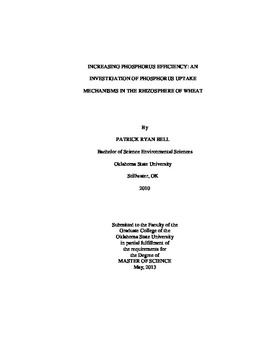| dc.contributor.advisor | Penn, Chad | |
| dc.contributor.author | Bell, Patrick Ryan | |
| dc.date.accessioned | 2014-09-24T14:17:54Z | |
| dc.date.available | 2014-09-24T14:17:54Z | |
| dc.date.issued | 2013-05-01 | |
| dc.identifier.uri | https://hdl.handle.net/11244/11065 | |
| dc.description.abstract | Phosphate reserves are declining in both quality and quantity and are expected to be depleted in the next 40-60 years. Increasing phosphorus (P)-use efficiency in agricultural systems is therefore warranted. The objectives of this study were to: screen twenty-two winter wheat accessions for phosphorus efficiency in acid and calcareous low P soils and characterize the them as P-uptake or P-utilization efficient or inefficient, and the second objective was to analyze the rhizosphere of the P-uptake efficient accessions to determine what mechanisms these plants utilize to access typically non-plant available P. To screen the accessions, plants were grown in low, medium, and high P acid and calcareous soils for 28 days. Biomass and P-uptake were measured and analyzed to characterize the accessions. Three P-uptake efficient and three P-uptake inefficient accessions from each soil type were then grown for 28 days in rhizo-cells. Five soil depths from 0-3.75mm at increasing distance away from the roots were analyzed foIn the acid soil, six accessions were characterized as primarily P-uptake efficient and three accessions as P-utilization efficient. In the calcareous soils, six accessions were characterized as primarily P-uptake efficient while four were characterized as predominantly P-utilization efficient. For the accessions chosen for the rhizosphere analyses in the acid soil, oxalic and citric acid as well as pH changes were identified as the mechanisms being utilized by the plants to access relatively non-labile P. The pools impacted by these mechanisms were the NaOH-IP, NaOH-OP, and HCl-P pools. For the calcareous soil rhizosphere analyses, oxalic and citric acid were again observed as important exudates as well as alkaline phosphatase enzymes. The pools impacted by these exudates were the NaHCO3-IP, the NaOH-OP, and the residual-P fractions. From this study it is concluded that plants exhibit varying responses and abilities to handle low-P environments. Plants use multiple exudates to access multiple fractions of P that are typically recalcitrant. Additional work is needed to identify genes controlling the release of the identified exudates in order to effectively incorporate these P-uptake efficiency mechanisms into new accessions. r organic acids, phosphatase enzymes, soil pH, and P forms. | |
| dc.format | application/pdf | |
| dc.language | en_US | |
| dc.publisher | Oklahoma State University | |
| dc.rights | Copyright is held by the author who has granted the Oklahoma State University Library the non-exclusive right to share this material in its institutional repository. Contact Digital Library Services at lib-dls@okstate.edu or 405-744-9161 for the permission policy on the use, reproduction or distribution of this material. | |
| dc.title | Increasing Phosphorus Efficiency : an Investigation of Phosphorus Uptake Mechanisms in the Rhizosphere of Wheat | |
| dc.type | text | |
| dc.contributor.committeeMember | Carver, Brett | |
| dc.contributor.committeeMember | Klatt, Art | |
| osu.filename | Bell_okstate_0664M_12628.pdf | |
| osu.accesstype | Open Access | |
| dc.description.department | Plant & Soil Science | |
| dc.type.genre | Thesis | |
